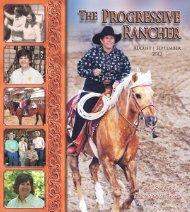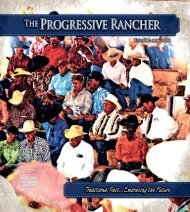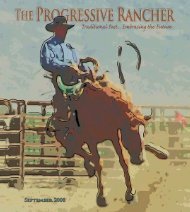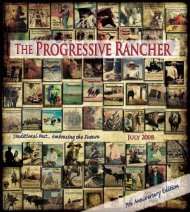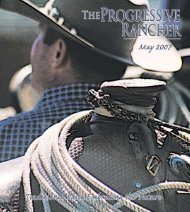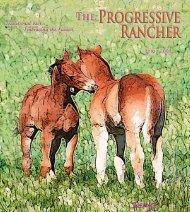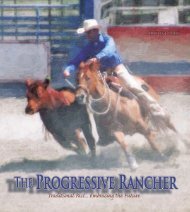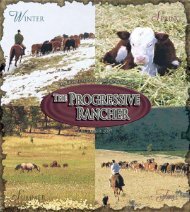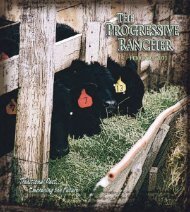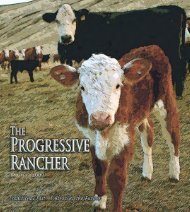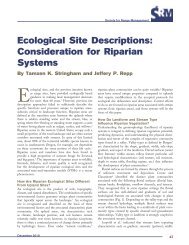NCA 2009 President's Award Recipient - The Progressive Rancher ...
NCA 2009 President's Award Recipient - The Progressive Rancher ...
NCA 2009 President's Award Recipient - The Progressive Rancher ...
Create successful ePaper yourself
Turn your PDF publications into a flip-book with our unique Google optimized e-Paper software.
Flying In the Face of Common Sense<br />
If one were to ask almost any rancher in the inland west to name the three most pressing<br />
and or threatening issues to their livelihood in the spring of 2013, their responses<br />
would undoubtedly include sage grouse, drought and the federal regulations which spawn<br />
therefrom, wildfire, and intrusion from the federal and state agencies into their ability to<br />
make a living. Because the 2015 target date for a decision as to whether or not the sage<br />
grouse will be placed on the threatened or endangered species list is rapidly approaching,<br />
this issue commands primary concern. One has only to look to western Owyhee County in<br />
Idaho where several ranchers are facing massive cuts of their grazing permits due to sage<br />
grouse to realize that the threat is real and imminent.<br />
Armed with “shaky” science and revisionist history, the anti-domestic livestock grazing<br />
forces have appropriated the sage grouse as their primary weapon much as similar<br />
forces exploited the spotted owl to cripple the timber industry in the Pacific Northwest<br />
several decades previous.<br />
<strong>The</strong>re have been literally hundreds of studies and comment documents prepared by individuals,<br />
sportsman’s groups, livestock and farming associations, as well as local and state<br />
governments to mitigate the negative effects of the United States Fish and Wildlife Service<br />
(USFWS) Status Review and Petition to List the Greater Sage Grouse as an endangered<br />
species. Central to all considerations for a listing decision are total population and trend<br />
information of a targeted species relative to potential threats. <strong>The</strong> Owyhee Cattlemen’s<br />
Association/Idaho Cattle Association document using the data of noted researcher W. F.<br />
Price who has relied extensively on diaries and journals of early explorers most notably<br />
Meriwether Lewis in 1805, Peter Skene Ogden in 1824-29, John Work – 1830-31, concluded<br />
that the factual historic record clearly shows that the birds were relatively scarce or absent<br />
over much of the range they occupy today, and that current populations and occupied<br />
habitat is significantly greater than during pre-settlement times, indicating a net positive<br />
outcome, which is diametrically opposed to the position taken by the USFWS in their listing<br />
petition. According to Price, the pre-settlement claims are “at best a misstatement of<br />
fact and at worst a deliberate misrepresentation of the historic record…the fabrication of a<br />
pre-settlement history, which did not exist, must cast doubt as to whether any of the purported<br />
documentation of information in the petition is accurate, legitimate, and presented<br />
without deception or bias.”<br />
<strong>The</strong> “Status Review and Petition” claims an adverse relationship between livestock<br />
grazing and sage grouse populations. This is of course the position of several environmental<br />
groups whose mission is to eliminate livestock grazing entirely on federal lands. This<br />
assertion is completely at odds with the historic data. Livestock grazing on the public domain<br />
generally began in the 1860’s and reached its peak in the early decades of the 1900’s.<br />
Perhaps not coincidentally, those figures parallel the sage grouse populations of the same<br />
period. Historic journals indicate relative scarcity of sage grouse in the Intermountain West<br />
during the period from 1820-1850 and vast flocks of sage grouse from the 1870’s to the<br />
1950’s. <strong>The</strong>re has been a major decline in numbers of livestock and in sage grouse populations<br />
from the 1950’s to the present. This data does not support the theory that there is an<br />
adverse relationship between livestock grazing and sage grouse. To the contrary, it actually<br />
suggests a positive relationship.<br />
Most studies agree that there are several contributing factors to the decline in sage<br />
grouse numbers. Near the top of the list are wildfires, disease (West Nile Virus), and predation<br />
– raiding of nests and killing of chicks in the spring, and killing of adults mainly by<br />
raptors and coyotes during the winter. A series of late, cold wet springs can also have<br />
a significant detrimental effect on chick hatch and subsequent survival. At the top<br />
of the predator list is the raven-which just<br />
happens to be a protected species – followed<br />
at some distance by the coyote.<br />
Many experts also point to habitat<br />
destruction as a primary threat to sage<br />
grouse populations. I am sure that all agree<br />
that the massive wildfires which have<br />
destroyed hundreds of thousands of acres<br />
of sage grouse habitat in Owyhee County,<br />
Idaho, and throughout northern Nevada<br />
since 1999 could not have helped but have<br />
had a negative impact on sage grouse numbers.<br />
So what is the answer? Yes, of course<br />
remove the cattle and sheep! I am sorry,<br />
but not only does this approach violate all<br />
historical evidence and research, it just<br />
by Linda Drown Bunch<br />
For What It ’s Worth<br />
Many people confuse crows with ravens. Crows are smaller, have squared-off<br />
or fan-shaped tails, and more slender bills. Ravens often soar; crows never do.<br />
If the bird does a barrel roll, it’s a raven. Crows caw; ravens croak and mutter.<br />
Raven voices are more varied and much deeper and throatier than the crow’s<br />
monotonous nasal call.<br />
Common ravens grow to about 25 inches in length and weigh more than 2<br />
pounds. <strong>The</strong>y can live for more than 20 years and survive almost anywhere.<br />
By some estimates, raven populations nationwide have grown by 300 percent<br />
in the past 40 years. In Nevada, the increase is thought to be more like 600<br />
percent.<br />
Ravens are protected by the United States Fish and Wildlife Service under<br />
the “Migratory Bird Treaty Act”<br />
flies in the face of common sense!<br />
<strong>The</strong> Sage Grouse Conservation Plan adopted in September 2012 by the Elko County<br />
Commissioners includes the following provision:<br />
Develop a Pilot Project to monitor the effects of historical grazing, predator control<br />
and range management methods and their impacts on the Sage Grouse Populations and<br />
Habitat.<br />
Issue:<br />
Lack of current specific data concerning the effects on Sage Grouse Populations and<br />
Habitat when utilizing historical Livestock Grazing, Predator Control and Range Management<br />
policies and measures.<br />
Actions:<br />
1) Propose the identification of a specific Pilot Project area of approximately 72 square<br />
miles to 216 square miles in size to implement historical livestock grazing, predator control<br />
and range management polices to develop scientific data related to the Sage Grouse populations<br />
and habitat.<br />
2) Implement and develop the Pilot Project using historical livestock grazing, predator<br />
control and range management polices to develop scientific data related to the Sage Grouse<br />
populations and habitat.<br />
3) Funding through the State of Nevada Department of Wildlife & BLM from Ruby<br />
Pipeline Sage Grouse Conservation funds.<br />
In March 2013 the Elko County Commission instituted the first known Pilot Project.<br />
<strong>The</strong> ranch chosen is the 15,000 deeded acre Devil’s Gate Ranch, owned by the Ken Bowler<br />
family, located about six miles north of the Elburz Exit on I80 as the crow, or should we<br />
say raven, flies. Central to the project are sensible livestock grazing which will manage the<br />
fuel load and reduce the risk of massive wildfire and predator control. <strong>The</strong> primary target<br />
will be the large resident raven population and the goal is to obtain permitted poison-laced<br />
eggs which are very effective in destroying the target species – ravens. Also hunting and<br />
trapping of coyotes and other predators will be encouraged.<br />
In the forty year history of the Endangered Species Act, this is the first known privatelocal<br />
government agreement with action on the ground to stave off a federal listing, commissioners<br />
said. It is a long-term project, and even if the sage grouse is listed, the project<br />
will continue to demonstrate that the bird numbers will improve if the federal government<br />
will increase, rather than decrease, grazing to prevent massive fires, and engages in reasonable<br />
predator control. <strong>The</strong> aim of the project is not to convince the USFWS, but to show<br />
the public and Congress that there is a direct correlation between federal land management<br />
policies since the 1950’s and the decline in sage grouse numbers.<br />
It is encouraging to see local entities and individual stakeholders taking matters into<br />
their own hands to come up with creative common-sense solutions to a major problem<br />
rather than relying on the agencies and their “scientific” studies. <strong>The</strong> USFWS and some<br />
environmental groups who will automatically close their eyes and plug their ears when<br />
confronted with any information that runs contrary to their stated agendas, are already<br />
criticizing the pilot project. Since they are not the target audience, the Elko County Commission,<br />
and hopefully the people and Congress, will not be deterred by this criticism. <strong>The</strong><br />
goal of the originators of the Elko County Pilot Project is for this pilot project concept to<br />
increase sage grouse to spread to not only other counties in Nevada but to other states as<br />
well. A county in Utah is already considering its own pilot project. It is also hoped that<br />
other ranchers will start looking at their operations to see if the Devil’s Gate Model<br />
could be adapted to them. Anyone interested in developing a pilot project should<br />
contact Randy Brown, Assistant Elko<br />
County Manager, at 775-738-6816, former<br />
Nevada Assemblyman John Carpenter at<br />
775-738-9861, or Elko County Commissioner<br />
Grant Gerber at 775-738-9258.<br />
(Linda Drown Bunch, a fourth generation<br />
Elko county native, was raised on the family<br />
ranch on the South Fork of the Humboldt<br />
River near Lee, Nevada, at the foot of the Ruby<br />
Mountains. Her parents later ranched in the<br />
Three Creek area of Owyhee County, Idaho.<br />
Linda began her teaching career at the Three<br />
Creek School where she taught for six years.<br />
She and her husband Randy then settled in<br />
Independence Valley where she taught at the<br />
Independence Valley School before retiring to<br />
raise horses and buck bulls.)<br />
www.progressiverancher.com <strong>The</strong> <strong>Progressive</strong> <strong>Rancher</strong><br />
April 2013 11



